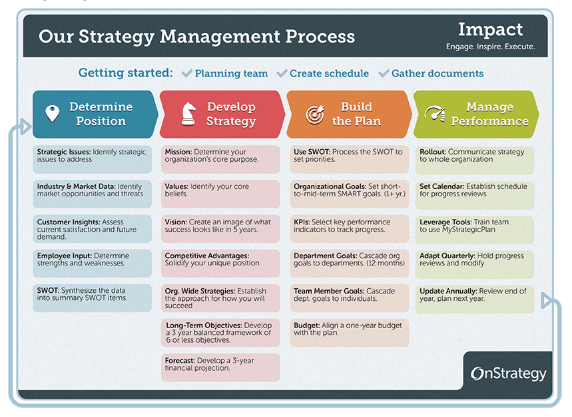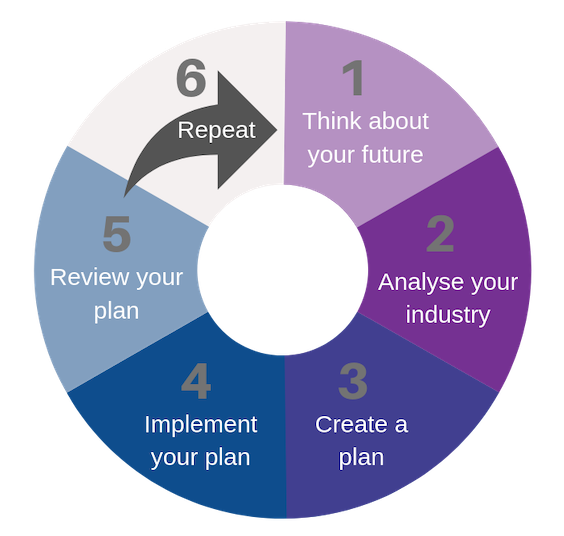Now that you’re no longer a startup, where should you spend your energy so you can take your business to the next level? The answer: strategic management.
This is about identifying long-term goals and mapping out a way to achieve those goals.
The strategic process includes thinking, analysis, planning and management. These four parts will eventually meld into one, but as you’re learning, it’s best to break each one down.
The 4 parts of strategic planning
There comes a time for every small business when a plan is needed to grow to the next level.
- Strategic thinking.
- Strategic analysis.
- Strategic planning
- Strategic management.
Strategic planning might sound complicated, but it can be broken down into four basic steps. Like a lot of things, it gets easier once you get the hang of it.
Part 1. Strategic thinking
Strategic thinking is when you consider your company’s future. How you think and make business decisions will change as your business grows. In the startup phase, you’re focused on short-term goals like:
- Finding your first customer
- Getting your name out there
- Developing your product or service

Once your business is established, you can begin to identify longer-range goals using strategic thinking. By asking questions and doing research, you can set goals that could take years to accomplish but will pay off in the end.
Part 2. Strategic analysis
Strategic analysis is the act of researching your market and identifying events and trends in your business environment.
This might be challenging at first, but it will become easier the more you do it.
By taking the time to delve deeper into what’s happening inside and outside of your business, you’ll be able to make better business decisions.
Part 3. Strategic planning

Image: OnStrategy
Now it’s time to put the thoughts and research from the first two parts of the process in writing. If you’ve ever made a to-do list or a mood board, you know the significance of writing down your thoughts and creating a visual connection. Not to mention the satisfaction of ticking off tasks once completed. A written strategic plan is your roadmap and to-do list.
Part 4. Strategic management
Strategic management is the cycle of doing the above three steps continually. Once you create a plan, you’ll select a time to review, evaluate and adjust your strategies. When you meet your goals, you’ll set new ones. If you fall short of your goals, you’ll determine why and adjust your plan as needed.
Let’s look at an example to put it into perspective.
Case study: Transportation through the ages
Hiring someone to drive you from point A to point B has existed since the horse-drawn carriage was invented. Over the centuries, a lot has changed in transportation, and the taxi industry has made adjustments to stay competitive.
When your local taxi company thinks about the future of transportation and what role they want to play in it, that is strategic thinking.
As the world’s transportation needs changed, taxi companies needed to understand how these factors might affect their business. The invention of the automobile, the car ownership boom of the 1930s, dispatching technology and apps have all had a significant impact through the years. The companies that spent time researching and understanding these external changes used strategic analysis to help them make better business decisions.
Writing a strategic plan was the next step. This is where they applied their strategic thinking and analysis to set tangible business goals.
Because the world is changing rapidly, the taxi company will benefit from reviewing its strategic plan regularly, continued research and adjusting their goals as needed. This is known as strategic management.
Why strategic planning matters
If you want your business to grow, it pays to be prepared. In the early 2000s, a local taxi company thinking about staying competitive probably focused their attention on building a mobile-friendly website and promotional activities. But taxi companies awake to the value of strategic management also spent time researching and analysing potential changes that could impact their business.
These companies were better prepared to make changes in 2010 when they heard whispers about a company called Uber that threw the industry into a tailspin.
Strategic management can help you:
- Spot external factors that could hurt your business
- Stay ahead of the competition
- Be ready to make proactive business decisions
- Achieve your business goals more easily
With practice and regular review, the process becomes second nature for many business owners.
How to get started
The strategic process will include team members, advisors and others you trust. Taking everyone’s thoughts and ideas and creating a roadmap is the best way to take your business to the next level.
Once you have your business goals written down, you can start to manage your strategy.
Managing your business goals is much like managing your employees. Employees aren’t a set-and-forget part of your business, and neither is your strategic plan.
The day you hired your first employee wasn’t the last time you spoke to them (let’s hope). You checked in with them frequently in the first few months, evaluated their performance, made adjustments when appropriate and communicated with them regularly.

Managing your strategy is similar. First, you need to write a strategic plan. Whether it’s comprehensive or brief is up to you and the nature of your business.
Then like your employees, you will check in with those goals regularly, analyse your success, make adjustments and adjust your action plan as needed.
How often should you review your strategic plan?
It depends on your business. If you’re in a slow-moving industry, you may find a yearly review is sufficient. If you’re in a tech business, it might need to be quarterly.
Strategic management can feel like you’re looking into a crystal ball and basing important decisions on the unknown. When you dedicate time to the process, you’ll be able to adapt when needed.
In a nutshell
Strategic management will guide you toward your goal and help you keep it all in perspective. It’s a process that will become easier over time. Start by thinking about your business and future goals, researching market trends, writing a simple one-page plan, and then make a date to do it again. The future is in your hands!





